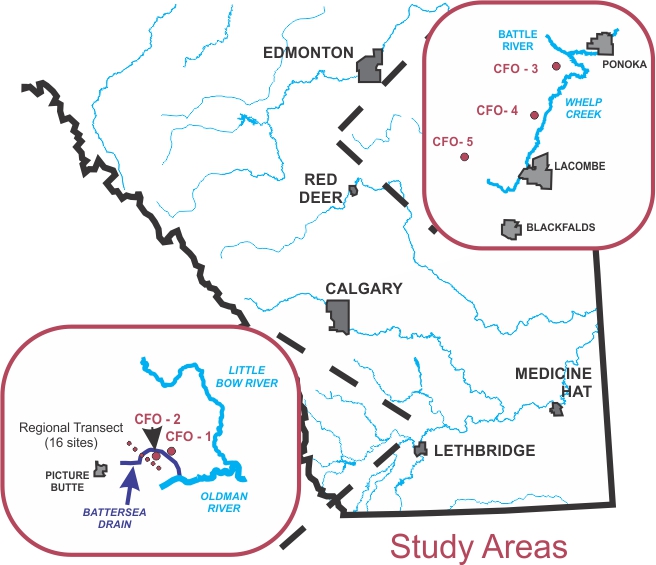| | The Big Picture
This study will:
- Provide science-based information on the potential risks of livestock manure management activities on groundwater quality in Alberta.
- Provide a better understanding of the processes affecting the fate and transport of manure constituents in the groundwater, under Alberta conditions.
- Recommend solutions to mitigate potential risks.
 The Study The Study
Alberta Agriculture and Forestry and partners implemented a 7-yr study to determine the potential risks of intensive livestock production to groundwater quality in Alberta.
Why Groundwater?
Agricultural manure management activities can contribute nitrogen, phosphorus, organic carbon, salts, and pathogens to groundwater. Recent reviews suggest that manure field application and storage facilities may pose a risk to groundwater quality in Alberta. However, little Alberta specific information exists.
Study Objectives
- Determine groundwater quality changes with time in the Battersea; an irrigated area, which has the highest density of confined feeding operations in Alberta.
- Determine the risks to groundwater quality from manure filed application and storage facilities on groundwater quality.
- Compare relative impacts between manure field application and storage facilities on groundwater quality.
Study Design
A total of 170 groundwater monitoring wells (78 water table wells, 82 piezometer wells) have been implemented in study areas in central and southern Alberta. The manure management activities of interest are:
- Manure field application
- Regional transect: A series of monitoring wells are being used to determine water quality changes in the Battersea area compared to previous work carried out about 10 yr ago.
- Field scale: Four field sites, with a history of beef manure application, are being studied to assess the potential groundwater contamination from manure spreading in southern Alberta.
- CFOs
- Beef feedlot sites: Two feedlots were instrumented with monitoring wells in the Battersea area (CFO-1 and -2).
- Dairy EMS sites: Four dairy earthen manure storages (EMS) are being monitored: one in southern Alberta and
three in central Alberta (CFO-3, -4, and -5).
Data collection includes groundwater elevation, vertical and horizontal flow, chemistry, and isotopes, as well as manure and soil characteristics.
2008 to 2011 Progress Report
Executive Summary
Section 1 - Introduction
Section 2 - Battersea Regional Transect Study
Section 3 - Field-scale Study
Section 4 - EMS and CFO Facilities
Section 5 - Comparison of Manure Spreading and CFO's
Section 6 - References
Section 7 - Appendices 1-3
Section 7 - Appendices 4-11
Review Reports
Manure Storage and Groundwater Quality (2007)
Manure Spreading and Groundwater Quality (2009)
Published Papers
Kohn J., D.X. Soto, M. Iwanyshyn, B. Olson, A. Kalischuk, K. Lorenz, and M.J. Hendry. 2016 Groundwater nitrate and chloride trends in an agriculture-intensive area in southern Alberta, Canada. Water Quality Research Journal of Canada 51(1):47-59.
Kohn J., M. Iwanyshyn, L. Miedema, B. Olson and A. Kalischuk. 2016. Shallow groundwater quality at a beef feedlot in southern Alberta. Canadian Biosystems Engineering/Le génie des biosystèmes au Canada 58: 1.11-1.19.
Bourke, S. A., J. Turchenek, E. E. Schmeling, F. N. Mahmood, B. M. Olson, M. J. Hendry. 2015 Comparison of Continuous Core Profiles and Monitoring Wells for Assessing Groundwater Contamination by Agricultural Nitrate.
Groundwater Monitoring & Remediation 35: 110–117.
Partners
- Producers in the study areas
- Alberta Agriculture and Forestry
- Natural Resources Conservation Board
- University of Saskatchewan
- Alberta Irrigation Projects Association
Additional contributions have been provided by Alberta Environment and Parks, Universities of Alberta and Kansas, Canadian Water Network, and Agriculture and Agri-Food Canada.
Alberta Groundwater Facts
- 3% of allocated water is from groundwater
- 23% of population relies on groundwater
- Groundwater use is dominated by agriculture and municipalities in southern Alberta, and by oil and gas in the northern part of the province
(Fennell 2011)
|
|